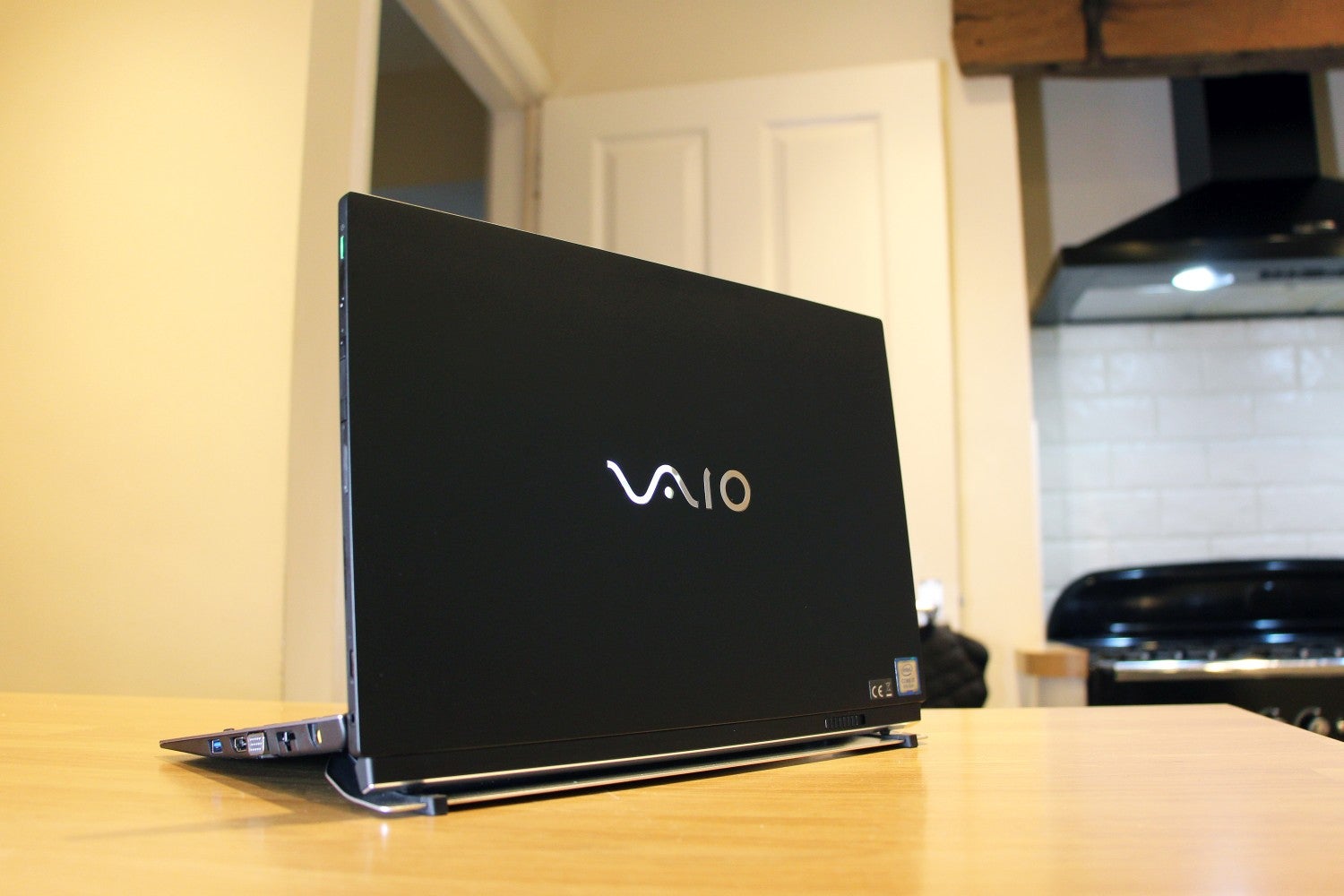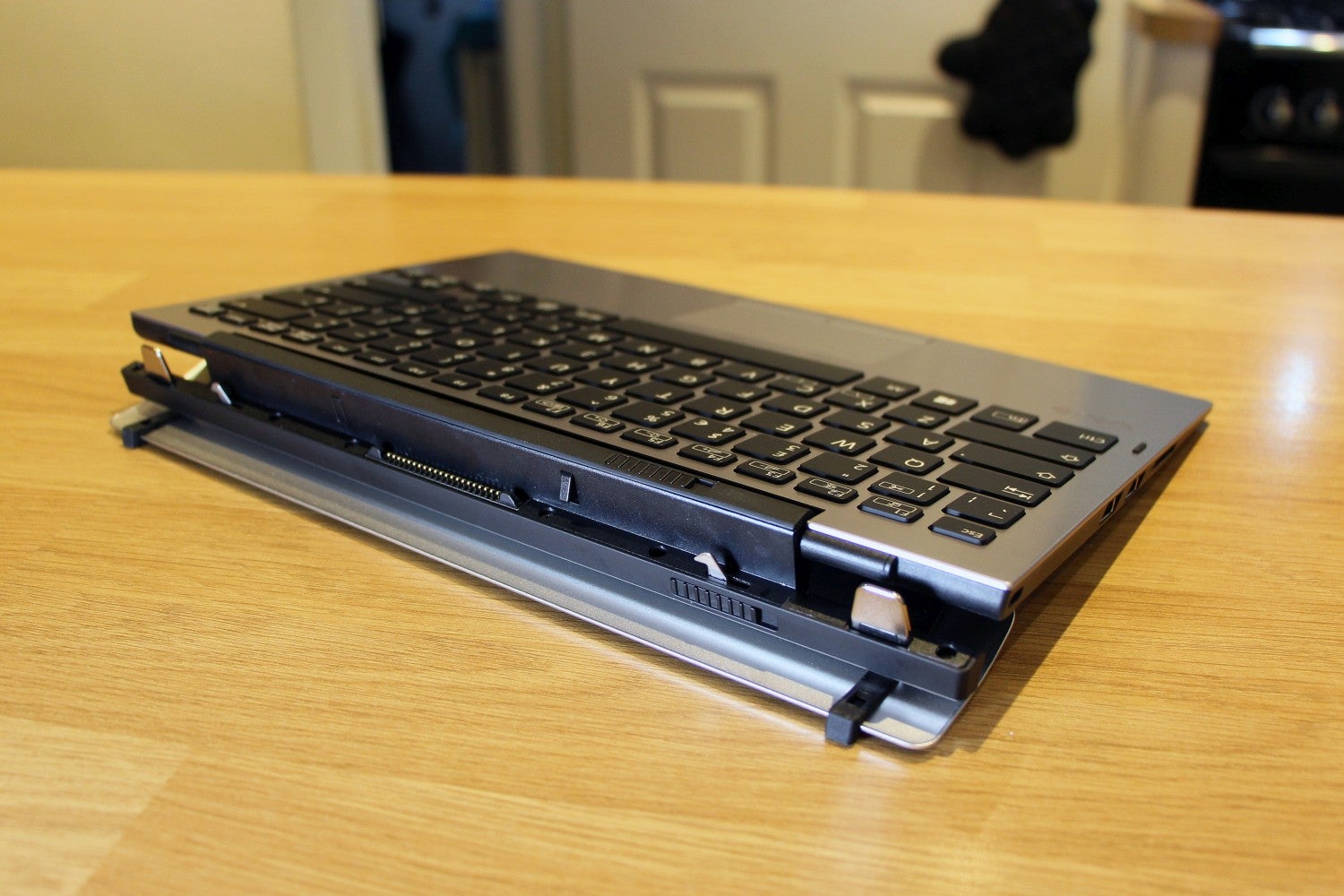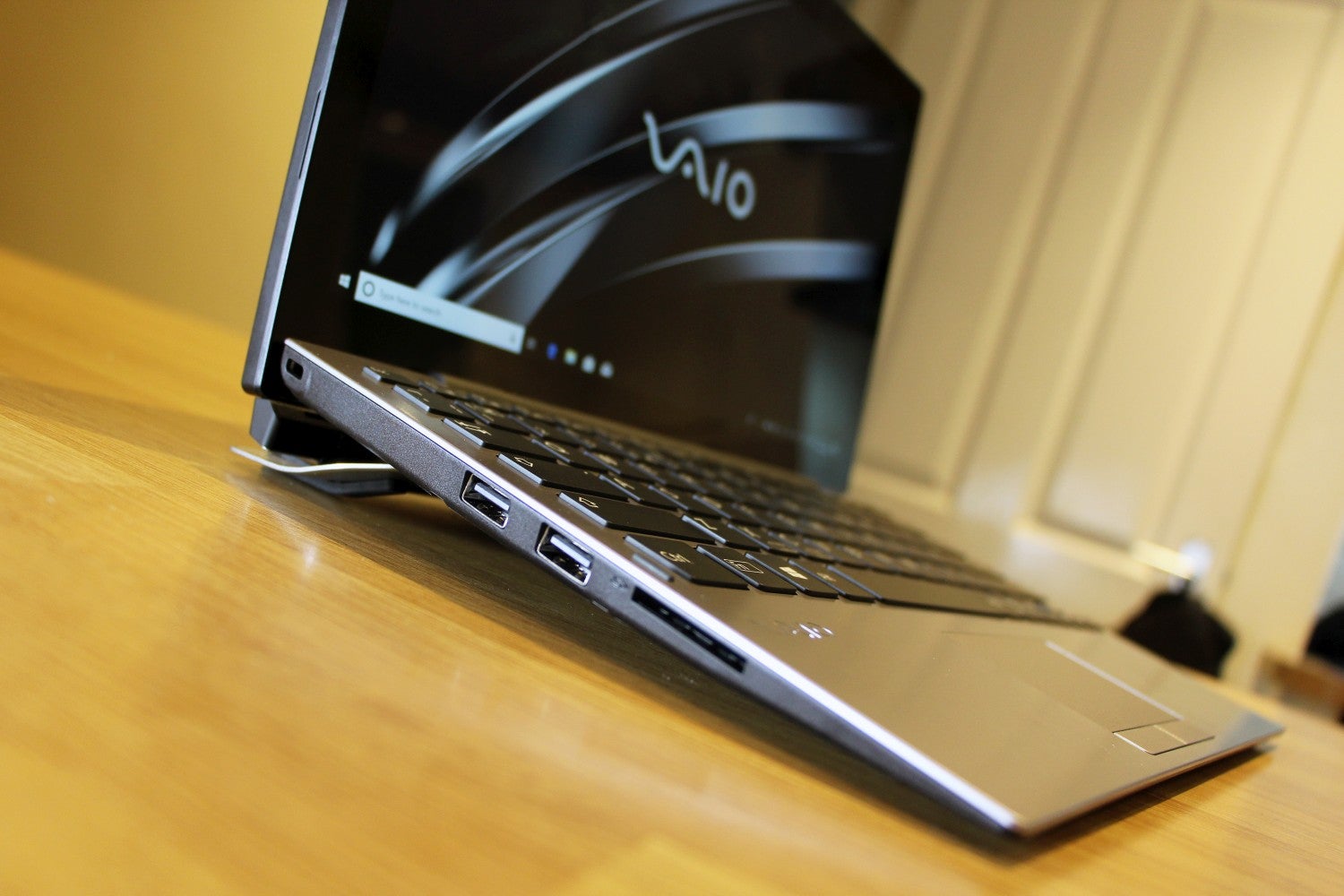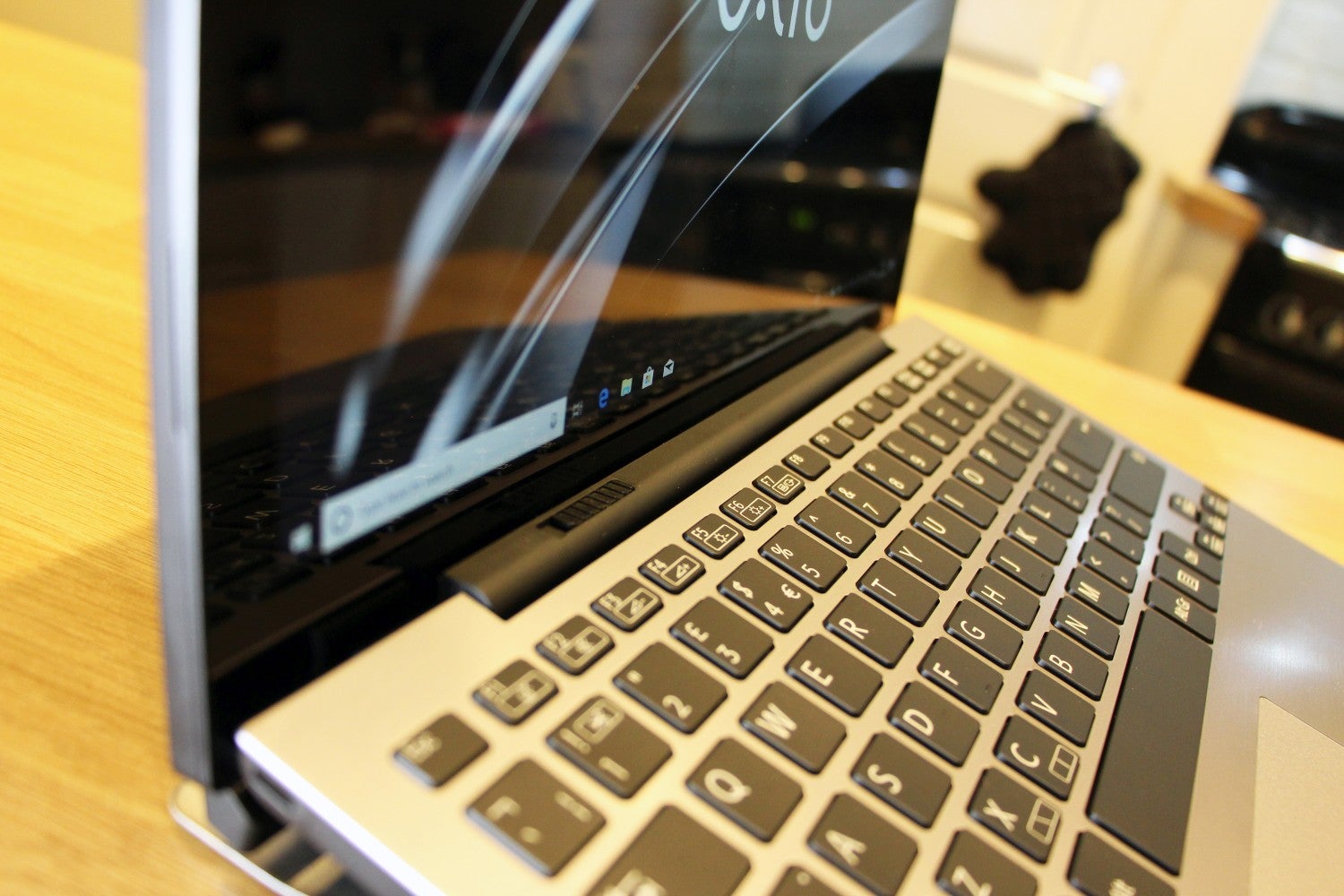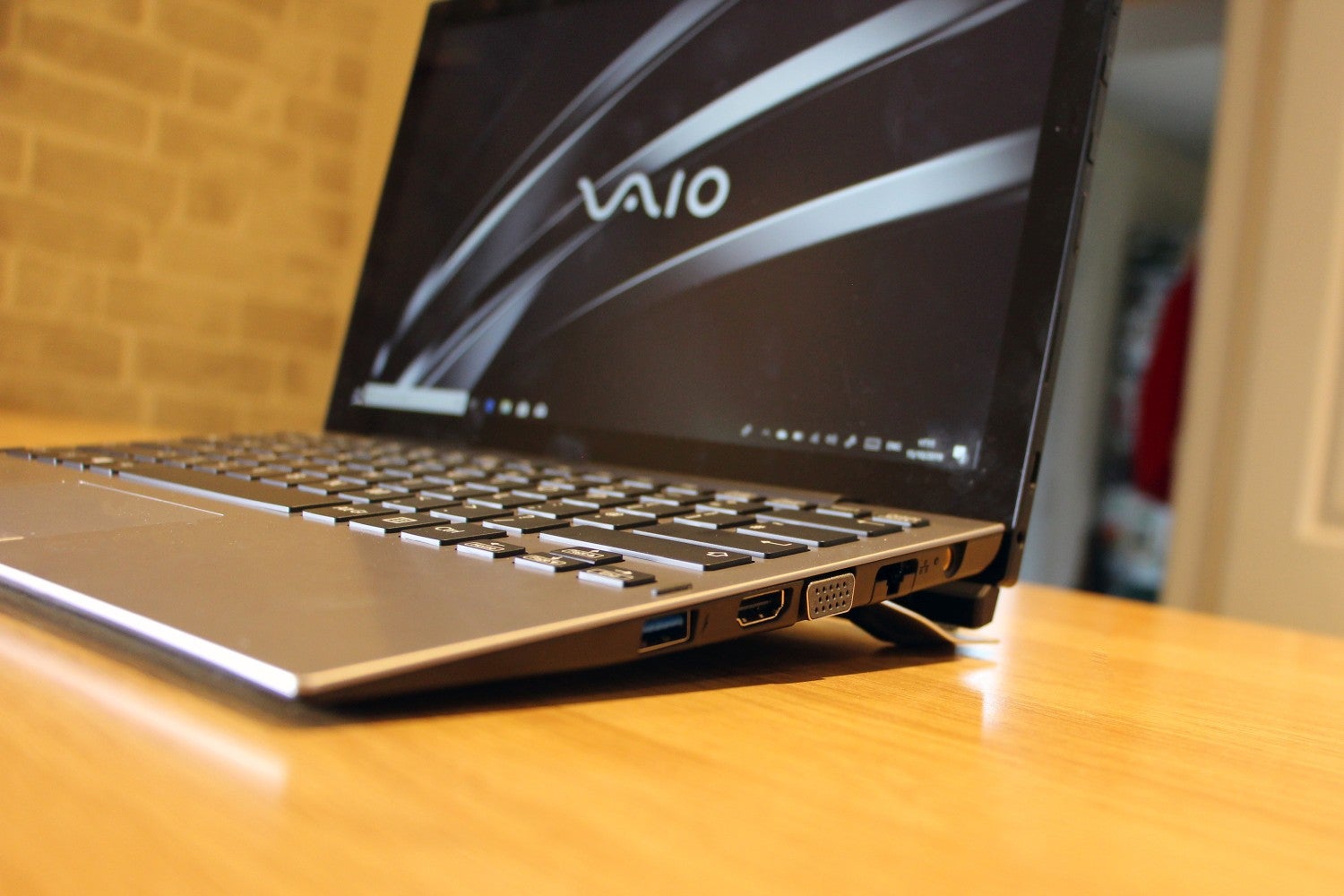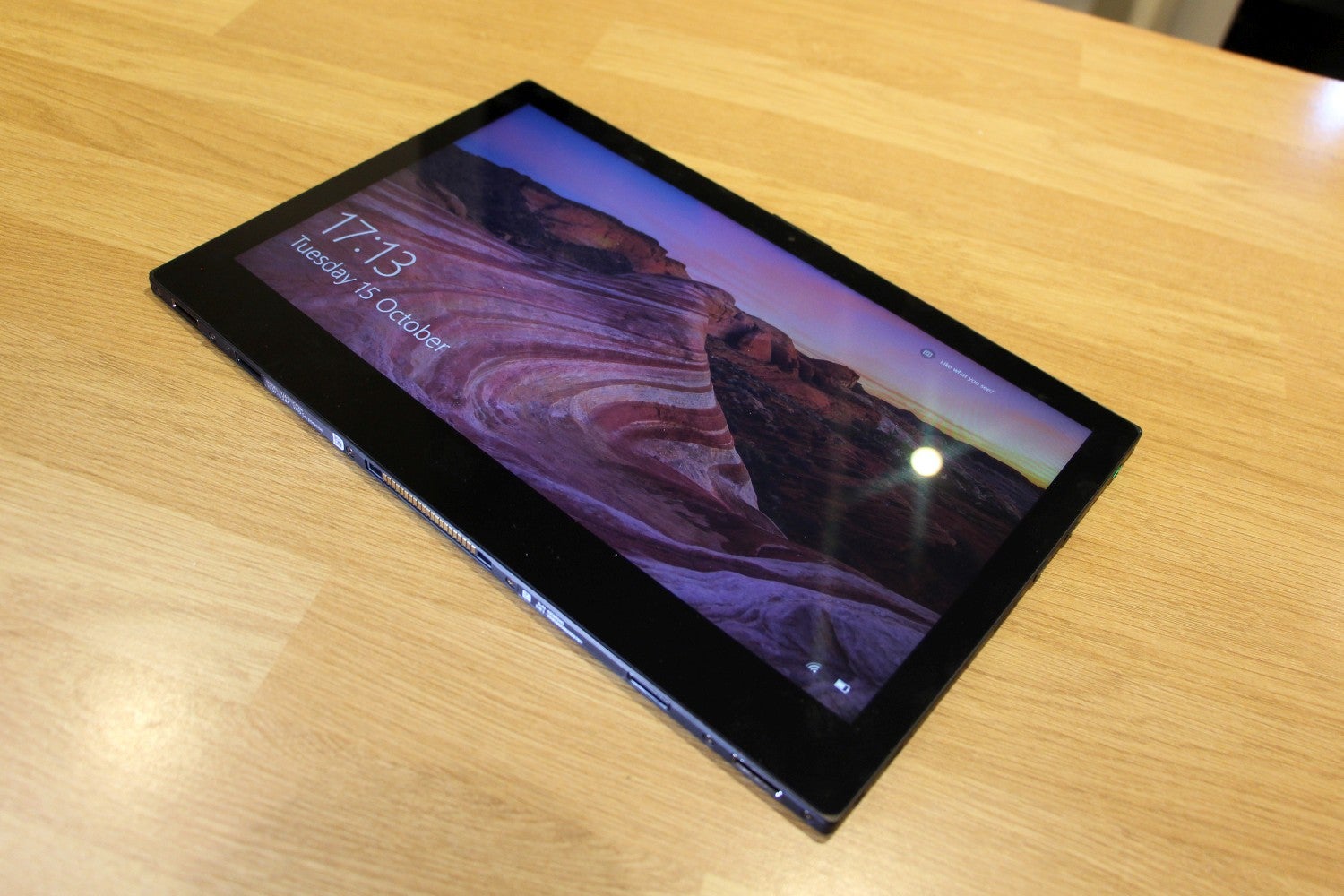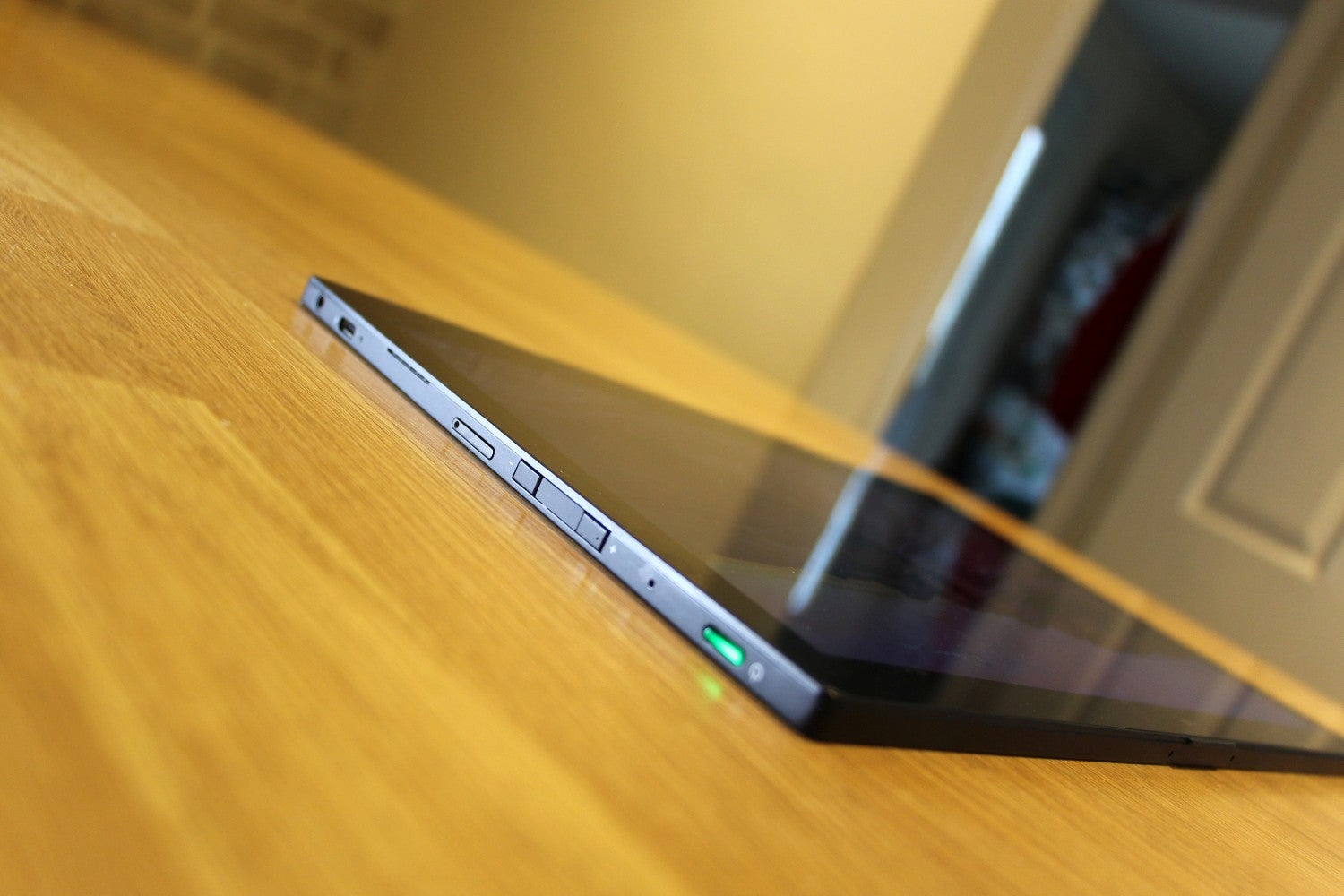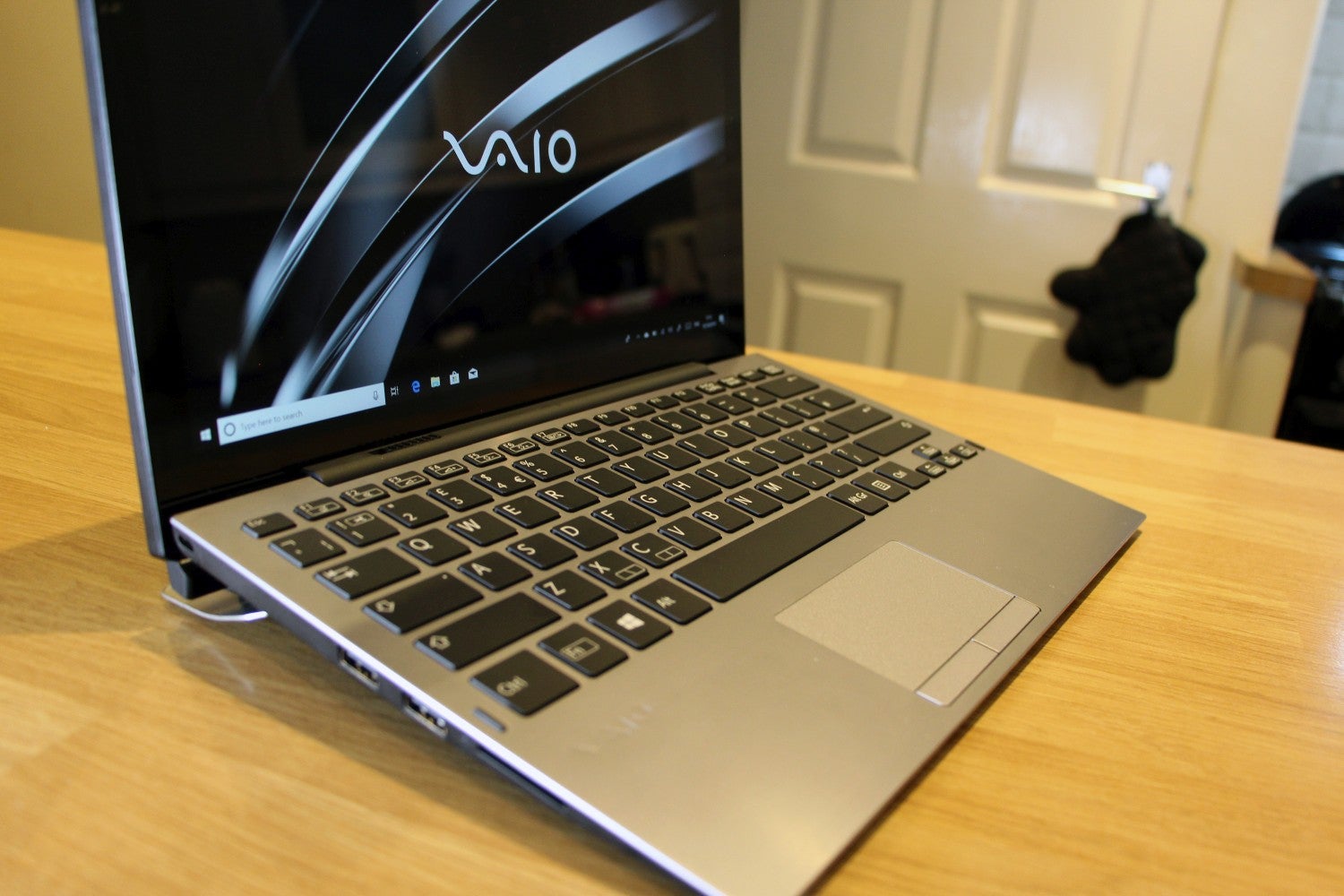VAIO A12 Review
VAIO A12 Review
The VAIO A12 is the first 2-in-1 from the revived brand
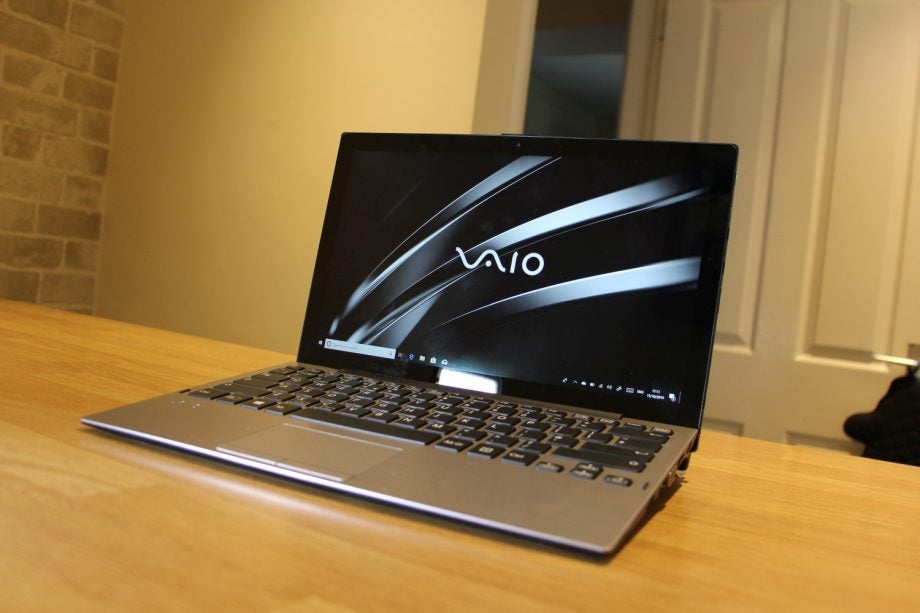
Verdict
A high price, underwhelming performance and inconsistent design hamper a solid concept from the well-known brand
Pros
- Attractive visual design
- Neat 2-in-1 mechanism
- Screen displays impressive contrast and touch functionality
- Enough computing power for day-to-day tasks
Cons
- Poor build quality throughout
- Keyboard and trackpad disappoint
- Rivals have better performance
- Extremely expensive
- Underwhelming battery life
Key Specifications
- Review Price: £2399
- Intel Core i7-8500Y CPU
- Intel HD Graphics 615
- 12.5in 1920 x 1080 IPS touchscreen
- 16GB LPDDR3 memory
- 512GB Samsung PM981 SSD
- 2 x USB 3.0, 2 x USB 2.0, 1 x USB 3.0 Type-C, HDMI, VGA, SD slot
- Windows 10 64-bit
- 2yr RTB warranty
What is the VAIO A12?
The VAIO name has been absent from the laptop market since Sony pulled the plug back in 2014. However, this year has seen the brand re-emerge – first in Japan, and now in Europe. It’s now licensed to a third-party company called Japan Industrial Partners, and the new VAIO A12 is the second machine to arrive in the UK.
The first, the SX14, was a decent attempt at an ultraportable laptop. The A12 is a convertible device that follows the same design blueprint.
VAIO A12 design and build – Too much flex, but connectivity is decent
The A12 has familiar visual appeal: you get the smart base with indented text, the familiar VAIO logo on the lid, and a chassis built from magnesium alloy and aluminium.
The right-hand side of the screen serves up a volume rocker that cleverly doubles as a fingerprint reader, and there’s an LTE socket for SIM cards. This business-focused machine also has TPM 2.0 and an IR webcam that supports Windows Hello.
Like the original VAIO SX14 laptop, the A12 deploys a neat design twist: a screen that’s larger than the base portion of the machine.
At the front, this means you get a neat lip to make opening the machine easier. At the rear, the larger lid pushes the base upwards when the machine is opened – which helpfully angles the keyboard towards the user.
The VAIO A12 looks good – but from a practical standpoint, the rest of this machine’s design is inconsistent.
The VAIO’s screen detaches from the keyboard, a form factor also used on the HP Spectre Folio and the forthcoming Microsoft Surface Pro 7.
There are positives. Removing the screen allows the A12 to function well as a tablet. It’s far easier to handle than machines that retain their keyboards, such as the Dell XPS 13 2-in-1. It also means you can leave your keyboard in your bag, and the screen can be flipped around and plugged in backwards – better for movie and media viewing.
The A12 weighs 1.11kg, with the tablet section arriving at 623g. Those are good figures – barely any different to the VAIO SX14, on par with the Surface Pro 7 and a little better than the 1.3kg Dell 2-in-1 and the 1.49kg HP.
The VAIO is 21mm thick, which makes it chunkier than any of Dell’s XPS models, Microsoft’s Surface devices and the HP Spectre. I’m talking about millimetres though, so the VAIO won’t prove problematic on the daily commute.
However, the mechanism has problems. The screen doesn’t feel secure when connected to the keyboard section; it’s easy to wobble it back and forth. The sliders that release the screen are also a little stiff.
Build quality is suspect across the whole device, in fact. There’s far too much bend and flex in the tablet section, with excessive give in the surfaces along seams that pull away from the rest of the device. The base section shows signs of flex as well, and when it’s propped up it rattles and feels hollow. If you’re commuting with the VAIO, a protective sleeve is essential.
The port selection is another area where the VAIO could be better. The A12 has four full-size USB ports, which is great for peripherals and more than most convertibles, but they’re divided between USB 2.0 and 3.0 – not faster 3.1.
The VAIO serves up a Gigabit Ethernet connector, which is rare on a convertible machine, but a boon for business, and there’s a Type-C socket that outputs to DisplayPort.
A full-size SD card slot is also rare, but it uses a USB 2.0 connection, which makes file transfers slow.
The A12 has HDMI and VGA outputs, but they’re too close together, so it’s tricky to use both at the same time.
On paper, no rival offers this much connectivity. However, you’ll find more Thunderbolt connections elsewhere. Rivals have better wireless too – the VAIO has dual-band 802.11ac, but the Surface Pro and the Dell XPS 13 2-in-1 both have Wi-Fi 6.
Ultimately, the VAIO’s design is disappointing. I’m always eager to see a hybrid that can function as a proper tablet, and the VAIO fulfils that remit while offering lots of ports – but it’s too flimsy and inconsistent to prove impressive.
Related: Best Tablets 2019
VAIO A12 keyboard and trackpad – Lack of travel and soft typing action aren’t ideal
The VAIO’s chiclet keyboard has a conventional layout. The main keys are large enough, the Return key is single-height and the cursor keys are smaller than the rest. There’s no number pad, but that’s to be expected, and the backlight is disappointing – it’s weak and isn’t adjustable.
Quality levels aren’t particularly high. The buttons don’t have much travel, and their typing action is soft. Compounding that issue, the base section’s weak build quality means that the centre of the keyboard is bouncy and feels hollow.
The VAIO’s keyboard is usable; despite the soft typing action, it’s easy enough to handle documents and web browsers.
However, virtually every other hybrid and laptop keyboard at this price will have more snap and a more rigid construction. Many of them will have more travel. If you’re a serious typist, then any rival machine will provide a more satisfying experience.
The trackpad has issues too. It’s smaller than the pads on many other hybrids and it has two discrete buttons. They’re small, which makes them more awkward to press when compared to pads that have the buttons built in. Those units are far more popular and easier to use, because you can just click anywhere vaguely in the corner of the pad.
Related: Best Laptops 2019
VAIO A12 screen and sound quality – It’s bright and vibrant, but colour accuracy is poor
The VAIO’s 1920 x 1080 resolution display is a 12.5in IPS panel with touch functionality. It has a glossy finish, which makes some work and media tasks tricky when compared to machines with more practical matte displays.
VAIO also includes a stylus. It has 4096 pressure levels, which is an impressive figure – the same as the Surface Pen. It works well, offering smooth operation and precision across the whole panel.
The screen is inconsistent, like so much else on the VAIO A12.
The brightness level sits at 334 nits, which is impressive and delivers enough punch to allow this machine to be used inside or outdoors. It’s paired with a black level of 0.23 nits, which is great; it lends darker areas real depth.
Those figures create a contrast ratio of 1452:1. It’s a superb result that delivers vibrancy and a keen level of detail across the whole colour spectrum. Whether you’re watching a movie, handling photos or browsing the web, the VAIO’s screen serves up plenty of punch.
However, colour levels are mixed. The temperature level of 6298K is fine, but the screen has a mediocre Delta E of 4.65 and an sRGB coverage level of just 69.2%. Those two results mean this panel only displays a relatively narrow band of colours – and they’re not particularly accurate.
Those wayward colour results mean this screen isn’t good enough for colour-sensitive photo work. It’s fine for web browsing, media duties and for other tasks where colour accuracy isn’t crucial, but I still expect better from a machine at this price. Also bear in mind some rivals, such as the Dell, can be configured with a 4K panel – and the VAIO doesn’t have that option.
The speakers are poor: tinny, with no bass and little treble punch. They’re good enough for Skype calls, but that’s about it.
Related: Best Student Laptop
VAIO A12 performance – Fine for the basics, but will struggle with anything more demanding
The VAIO A12 I’ve reviewed has an Intel Core i7-8500Y processor, and it’s paired with 16GB of memory and a 512GB Samsung SSD that delivers reliably good speed. That configuration costs a mighty £2399.
A model with a Core i5-8200Y, a 256GB SSD and 8GB of memory drops the price down to £1999 – still a huge sum of money.
The Core i7 and Core i5 CPUs both have Intel’s Y suffix, which means they’re low-power parts with improved efficiency, but reduced specifications.
For instance, the i7-8500Y has a TDP of just 5W, but that means you get only two Hyper-Threaded cores alongside base and Turbo clocks of 1.5GHz and 4.2GHz.
The choice of a Y-series CPU leaves the VAIO in a tough spot. It’s the same chip as the HP Spectre Folio, which was released earlier this year, but most other rivals offer more.
Conventional notebooks such as the Dell XPS 13 and several other convertibles use chips like the Core i7-8565U. While they consume greater power, they’re more powerful – that Core i7 part has four Hyper-Threaded cores and speeds of 1.8GHz and 4.6GHz.
Then you have newer machines such as the Dell XPS 13 2-in-1 and the Surface Pro 7, which use the i7-1065G7. That’s a brand-new Intel Ice lake part that’s superseding the i7-8565U in terms of its specification, with four cores and a more effective architecture.
In Geekbench’s multi-core benchmark, the i7-8500Y scored 7935 points – while the i7-8565U is twice as fast. The new i7-1065G7 nears 18,000 points in the same benchmark.
In PCMark 10, the VAIO A12 scored 3134 points – but its rivals are often 800 points better in this test.
In the Geekbench single-core test the Core i7-8500Y scored 4627 points. This is better, and not far behind the U-series chip and the new Intel i7-1065G7.
These results are no surprise: the i7-8500Y has clock speeds that aren’t far behind other chips, so it maintains good single-threaded speed. However, its power reduction means half as many cores, which explains the poor multi-threaded result.
The low-power processor restricts what the VAIO A12 can accomplish. This machine has no problem with web browsing, even with multiple tabs open, and it will handle Office applications easily. You’ll just about manage light photo-editing too.
However, the lack of multi-core ability means tougher work software will not run well. You’ll struggle with running numerous applications simultaneously too. The VAIO’s Core i5 variant will function similarly, and you’ll need one of those better chips if you want to get more intensive work done on the road.
The VAIO has a 23.4Wh battery, which is tiny. Most other laptops in this class have 50Wh power packs at least. As a result, longevity is poor.
The A12 lasted 4hrs 37mins in our standard Powermark test, which runs the screen at 150 nit brightness and uses web browsing and video calls. In a simpler test, with just a web browser running, the A12 lasted 6hrs 47mins.
You’re not going to make it through a whole day with this machine, even if you’re being careful about screen brightness and what apps you use. If you do anything more intensive with the VAIO, or want to really use that screen, you won’t even make it through to lunch.
Related: Best streaming sites 2019
Should I buy the VAIO A12?
I’m always pleased to see new players in the laptop market, and the return of VAIO is an exciting addition.
However, the VAIO A12 makes too many mistakes to earn a recommendation. On the outside, it isn’t too heavy and it has a detachable mechanism, but build quality is poor and its port selection is inconsistent. The keyboard and trackpad aren’t good enough for work.
On the inside, performance isn’t good enough to handle tough productivity software, the screen displays underwhelming colours, and the battery falls behind lots of other machines.
The price is huge too, whether you opt for the Core i5 or Core i7 models. You can spend less on machines like the Dell XPS 13 2-in-1, the HP Spectre Folio or the Microsoft Surface Pro 7 and get a more productive, satisfying experience.
While it’s good to see VAIO back in the market, the A12 is expensive and underwhelming. Just like the SX14, it’s worth looking elsewhere for more quality and computing ability – while waiting to see if VAIO’s next generation is better.
Verdict
The VAIO A12 looks decent, isn’t too heavy and has a detachable mechanism, but it falls down in several key areas: build quality isn’t great, its ergonomics are underwhelming, and its internals restrict what it’ll actually get done – alongside its poor battery. The various negative attributes and the high price mean other convertible devices are better business options.
How we test laptops
Unlike other sites, we test every laptop we review thoroughly over an extended period of time. We use industry standard tests to compare features properly. We’ll always tell you what we find. We never, ever, accept money to review a product.


